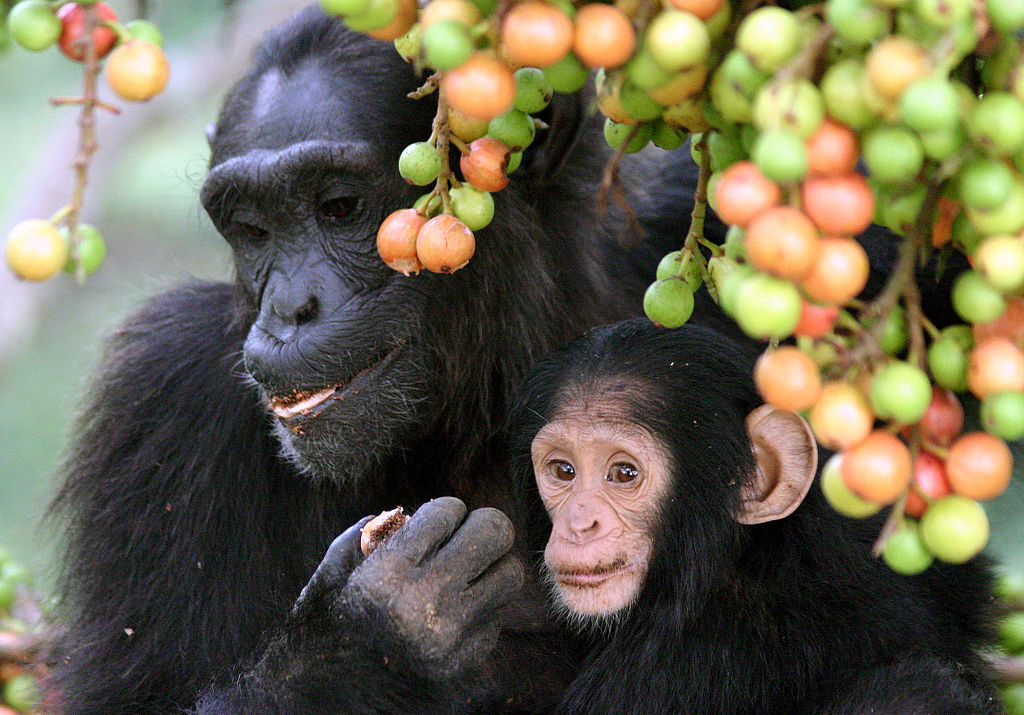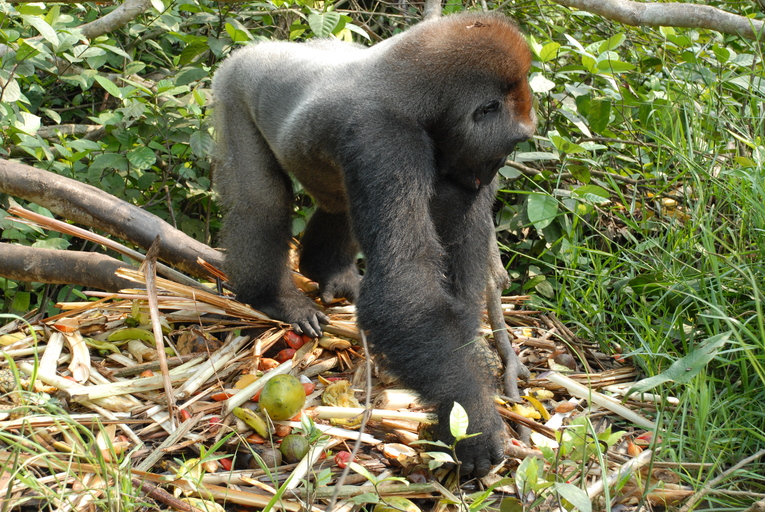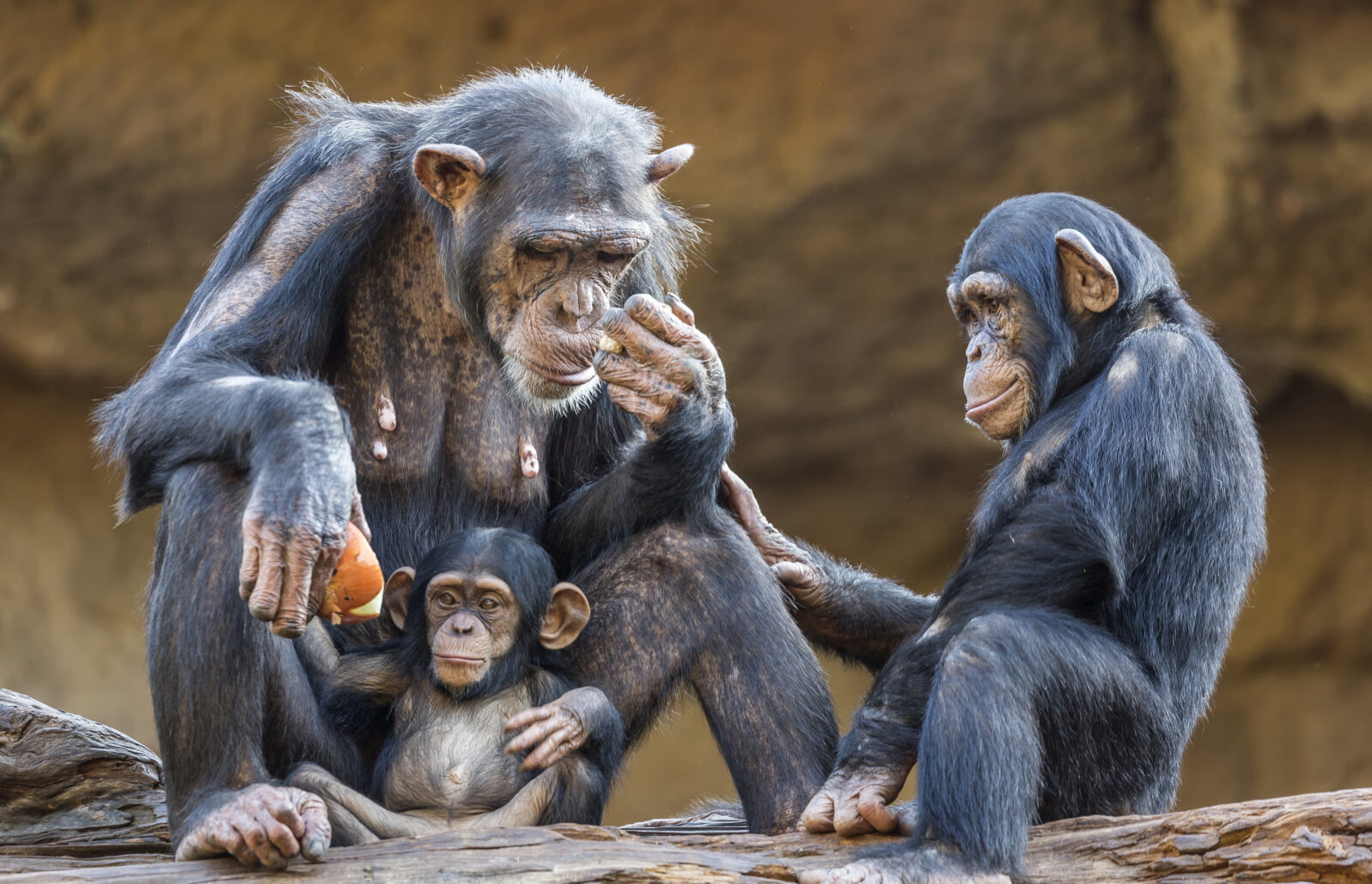Researchers: Apes Are Just Like Us!
And we’re not doing the right things to make them start behaving that way…According to comparative developmental psychologist Kim Bard, “Environment, not evolution, might underlie some human-ape differences,” charging that “underlying bias and poor experimental designs” account for the poor intellectual showing of apes as opposed to humans:
“These studies suffer from the same type of prejudice that once existed in studies of human intelligence, which started from a biased position of assuming northern Europeans were innately more intelligent than southern Europeans. We argue the same type of bias is apparent in cross-species studies.”
Professor Bard said: “Historically, many researchers have claimed humans are superior to apes in social intelligence, but the research is based on studies of captive adult apes isolated from European-style social interaction and human (usually children) from rich western cities. These experiment designs are simply not valid for the comparative study of species differences.
University of Portsmouth, “Environment, not evolution, might underlie some human-ape differences” at ScienceDaily, 15 July 2019
Apes are just like us but for some reason, they do not behave that way? Actually, we have been here before and will doubtless be here again. In 2011, Erin Wayman told us at Smithsonian Magazine, “‘Talking’ apes are not just the stuff of science fiction; scientists have taught many apes to use some semblance of language.” Have they? If so, why has it all subsided? What happened?
We have been informed, over the last few decades, of at least six “talking apes”:
- Viki, a female chimpanzee who died in the early 1950s at seven years of age from viral meningitis. She was raised like a child and is said to have learned to say four words, “mama,” “papa,” “cup,” and “up.” Most later programs have focused on teaching primates American Sign Language instead because physical speaking is difficult for them in principle.
- Washoe (1965–2007), a female chimpanzee, according to Smithsonian, learned 250 signs.
- Chantek, a male orangutan (1977–2017) raised by humans, who “could clean his room and memorized the way to a fast-food restaurant,” knew 150 signs.
- Koko (1971-2018), a female gorilla was said by her trainer Francine Patterson to know 1000 signs but the claim is disputed on account of the lack of hard data.
- Kanzi (1980–), a male bonobo, is said to know 348 symbols.
- Nim Chimpsky (1973–2000), a male chimpanzee, knew more than 125 American Sign Language signs.

Their linguistic abilities were often touted as bordering on human language skills. But there was a persistent murmur of doubt and dissent in the background, always drowned by unthoughtful media coverage of the “talking apes.” Then several things happened in the past decade.
People became more sensitive to the cruelty of depriving an intelligent animal of a normal lifestyle. Nim Chimpsky’s sad fate, for example, is documented in Project Nim.
The goal of the project was to see if the animal, named Nim Chimpsky, could be conditioned to communicate with humans if he was raised like a human child in a human household. He learned some very basic words in American Sign Language, but Nim continued to act like a chimp — he bit the children in the house and didn’t understand how to behave like a human child. It was decided that the family could no longer care for Nim, and he was shuffled from caretaker to caretaker for several years.
In 1977, Nim attacked one of the people taking care of him, and the experiment ended. At that point, researchers said he knew more than 125 ASL signs — but no one knew quite what to do with Nim. He was sent to a medical research facility, where he lived in a cage with other chimps for the first time in his life, before being rescued and sent to an animal sanctuary. He died in 2000.
“‘Project Nim’: A Chimp’s Very Human, Very Sad Life” at NPR, 2011
The story of the attack has been told more graphically:
As Nim got older, he became stronger, unpredictable—and violent (his teachers have the scars to prove it; he bit one woman’s face so hard that she had a gaping hole in her cheek for months.) This is normal for a chimpanzee. “Nobody keeps a chimp for more than five years,” Terrace says. Soon Terrace ended the project.
Erin Wayman, “Rise of the Chimp Movies” at Smithsonian.com
The way Nim was treated after the experiment ended is grim reading. It’s not clear, however, whether he would have adjusted to life with other chimpanzees. For many observers, that prompted a question about the basic ethics of “raise the chimp with humans” experiments.
But there was another problem as well: The apes never really learned human language and were not likely to. For example,
Unlike us, however, it seems that apes don’t care to chitchat. Psychologist Susan Goldin-Meadow points out that studies with Kanzi show that only 4 percent of his signs are commentary, meaning the other 96 percent are all functional signs, asking for food or toys. Similar skepticism about Koko emerged in the 1980s, when Herb Terrace, Nim Chimpsky’s former foster parent, published a fairly scathing critique of ape language research, leading to a back-and-forth with Patterson via passive-aggressive letters to the editor of the New York Review of Books. Among other criticisms, Terrace asserted that Koko’s signs were not spontaneous but instead elicited by Patterson asking her questions. Patterson defended her research methods, then signed off from the debate, saying her time would be “much better spent conversing with the gorillas.
Jane C. Hu, “What Do Talking Apes Really Tell Us?” at Slate
Koko’s ability, it was pointed out, fell well short of a fluent human signer. Moreover, Ms Patterson was her interpreter, a role that invited the question of how much she was inferring what Koko “must have meant”, and explaining away random signs. (Koko was particularly fond of “nipple”.) It was hard to be sure: Ms Patterson preferred speaking to journalists over sharing her video and raw data about Koko with fellow researchers.
“What Koko the gorillas could and couldn’t do” at The Economist

A skeptic observed in 2018:
Not only did signing apes never become common, the number of research programs studying ape signing has gone from a few to even fewer. At its peak in the 1970s, the field of teaching apes to communicate with humans never had more active research programs than you could count on your fingers and toes; today, there is not even a single program anywhere in the world making publishable claims. Backwards is not where promising directions in research tend to go. In every field of science, when we see researchers abandoning projects, the reason nearly always tends to be that the project was a dead end.
The apes were using their symbol knowledge really only as a type of begging, when they wanted to play, eat, drink, or be tickled — little different than a dog pushing its bowl over to you with its nose when it is hungry. Any claims grander than this — for example, of sentence structure or evidence of emotions or how the ape was feeling — were likely nothing more than self-deception on the part of researchers who would prompt their apes and over-interpret their responses.
Brian Dunning, “The Apes Who Learned Sign Language” at Skeptoid, 2018
One writer understands the story as the recurring fairy tale of the Animals That Can Talk:
“But like all fairy tales, the one about talking apes is partly make-believe. No matter how much we wish to project ourselves onto them, they are still apes—albeit very intelligent ones. They deserve our respect, and, at the very least, proper care. Our original plan for these apes—to study their capacity for language—has more or less been achieved, and it’s unclear how much more we can learn, as apes like Koko and Kanzi are reaching old age. Through these projects, we’ve learned about the ability of nonhuman apes to associate symbols or signs with objects in the world and to use this knowledge to communicate with humans. We’ve learned about the uniqueness of human language. But we may also have learned something about how strange, stubborn, and fanciful we can be.”
Jane C. Hu, “What Do Talking Apes Really Tell Us?” at Slate
And fairy tales never die; they morph into different forms in different cultures. At NOVA in 2018, beneath a standout statement that “Apes and humans are even more similar than we ever imagined,” we were told that
Scientists have been trying to teach chimps to speak for decades, with efforts ranging from misguided to tantalizingly promising. Now, however, they are coming to realize that we’ve likely been going about it in the wrong way. Rather than force apes to learn our language, we should be learning theirs.
Researchers have only just begun to understand the rudimentary fundamentals of ape communication, but already the results are exceeding expectations. Apes and humans, they are discovering, are even more similar than we ever imagined.
“Pretty much all of the capacities we thought of as being uniquely human—learning socially, using communication to reach a goal, shifting our communication depending on who we’re communicating with, being able to plan for the future, keeping record of friends and enemies—actually are not,” Hobaiter says. “They’re all present in chimps.”
Rachel Nuwer, “To Communicate With Apes, We Must Do It On Their Terms” at NOVA
Later in the article, we are informed that a researcher has compiled a list of 60 to 80 gestures that she believes to be “ape language phonics.” We are told, “Distilling the meaning of those various sounds and gestures when put together, however, will be a much more challenging and drawn-out task.”
Indeed, and it’s a task no ape would think to do. But we are expected to avoid considering the significance of that fact. And, to preserve the truthiness of the fairy tale, most readers gladly comply.
Further reading: Apes can be generous Are they just like humans then? (Michael Egnor)
Can animals reason? My challenge to Jeffrey Shallit (Michael Egnor)
Does social ability distinguish human intelligence from that of apes? Not altogether, of course, but it plays a bigger role than we sometimes assume. (Denyse O’Leary)
Featured image: Chimpanzee mother with two youngsters/Henner Damke, Adobe Stock
